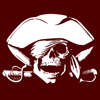It’s that time of the year again. Yes, September 19th is officially Talk Like A Pirate Day! So, here are several more expressions commonly used ashore that have their origins in life at sea.

By Captain Ray
Published: September, 2009
A deck constructed above the main deck at the stern of a vessel is called the poop deck. The term “poop” comes the Latin puppim, meaning the rear section of a ship. When sea conditions were bad enough to actually break over this raised deck, the vessel was in danger of being completely overwhelmed. Today, when we are overwhelmed by work, stress, or physical labor we are said to be “pooped.”
On all ships, it is the duty of those on watch to record the course steered and the distance traveled during their watch. A small slate was kept near the helm for this purpose. At the end of each watch, this information was transferred to the ship’s log and the slate erased, allowing the oncoming watch to “start with a clean slate.”
Sails often overlap each other, and so the forward-most sail, the “jib,” is the only one completely visible. Its dimensions, shape, and size often indicated the type of vessel and sometimes even its nationality. When taking an instant dislike to someone based on his appearance, an old-time sailor man would say, “I didn’t like the cut of his jib!”
In the days of sailing ships, the crew’s main meal of the day was served at noon. It usually consisted of dried salt pork, soaked in seawater and boiled. While eating this tough, gristly meat, the crew had one of the few opportunities in the day to engage in idle, friendly conversation. They could sit and talk amongst themselves, or, as it became known, “chew the fat.”
New hands, fresh from life ashore, found it hard to even walk (let alone perform their tasks) on the rolling deck of a ship at sea. As they became familiar with the ship’s motion and were able to function, they were said to have found their “sea legs.”
The Greek word for ship is naus, and that terrible feeling in one’s stomach (and one of the symptoms of seasickness) is called “nausea.”
Many old charts had a series of drawings around the margins. These drawings showed mariners what a harbor looked like from a distance or showed an island from several different sides to aid in identification. As a vessel approached a new shore, the navigators would compare these drawing with what they saw in order to understand “the lay of the land.”
Masts need to be supported by lines in order to remain in place and do their work. On ships with more than one mast, the most important is one is called the mainmast; the support for that mast is called the “mainstay.”
Until the advent of electronic depth sounders, water depth was established with a weighted line. The line would be heaved over and allowed to sink until the bottom was felt. The line was then hauled back aboard while counting the number of arm spans, each one approximately six feet (a fathom). When a sailor threw waste overboard, he was said to “deep six” it.
Ray Wichmann, is a US SAILING-certified Ocean Passagemaking Instructor, a US SAILING Instructor Trainer, and a member of US SAILING’s National Faculty. He holds a 100-Ton Master’s License, was a charter skipper in Hawai’i for 15 years, and has sailed on both coasts of the United States, in Mexico, the Caribbean, and Greece. He is presently employed as the Master Instructor at OCSC Sailing in the Berkeley Marina.

